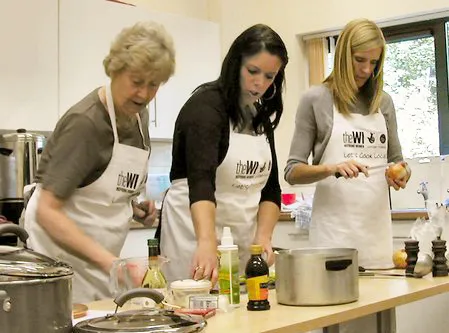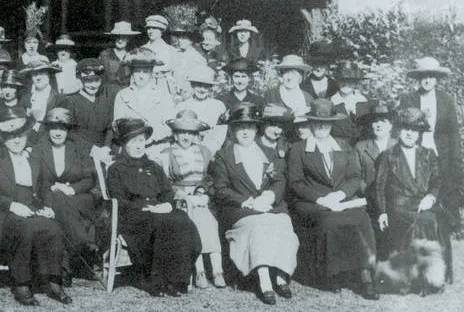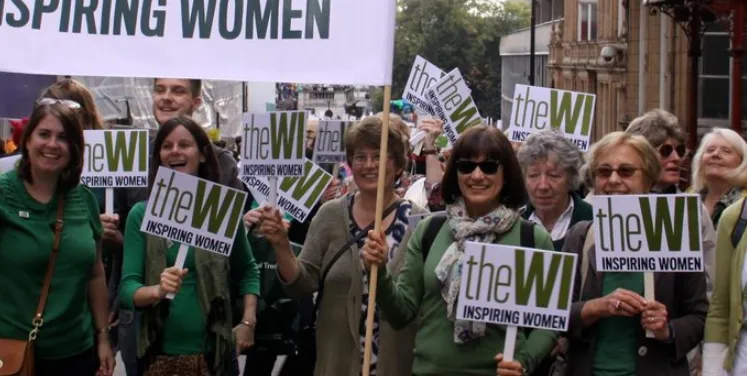
The Women’s Institute in England and Wales was born in 1915 at a time of great upheaval. The First World War saw tens of thousands of women drawn into the workforce, both on the land and in the towns. Things were changing for women. The WI’s first biographer wrote that while the Suffragettes had made the pot boil, the WI knew what to get out of the pot. Now, 100 years on, the world has altered dramatically, but the WI remains successful and relevant.
In the early 20th century, life was hard for country dwellers. An exodus of people to the cities in search of work had left farming bereft. Many farmers had gone bankrupt and unemployment among agricultural labourers was high. This brought great hardship to their dependents. Many communities were underpopulated and impoverished, financially and educationally.
Although academics had suggested for some time that it would be wise to educate farmers’ wives in order to improve life in the rural villages, it met with little interest until two events coincided. One was the very real prospect of serious food shortages during the First World War; the other was the arrival from Canada of Madge Watt. The world’s first Women’s Institute had been formed in Canada in 1897; and in 1911 Mrs Watt had been a founder member the British Columbia branch. Once in the UK, she campaigned to get the organisation started here, too.
So a century ago, with support from Bangor University, the UK’s first Women’s Institute opened on Anglesey, in a village with the longest name in Britain but usually known as Llanfairpwll. Once the movement began, there was no stopping it.

Class act
For many women, the WI made a significant difference to their lives. Sybil Norcott was born in 1928 and grew up on a farm near Manchester before joining the WI in 1940. Strictly speaking, she was two years too young to join, but this was overlooked as she accompanied her mother to meetings. After the war, her parents gave her two in-gilt pigs as a wedding present. These had 24 piglets and, later that year, Sybil used a WI grant to take her exams in butchery and, over the years, courses in public speaking and cookery demonstrations.
“If I had not been in the WI, I wouldn’t have demonstrated for the WI at Earl’s Court,” said Sybil. “I wouldn’t have met the Queen three times and done a demonstration for her. I would never have done all this without the WI.” Sybil remained a WI member until her death in 2014.

Great resolve
Initially, the WI’s annual resolutions focused on improving life in rural England and Wales. In 1920, the AGM resolved: “It is advisable to have women’s organisations, such as the Women’s Institutes, represented on parish councils, district councils and sub-committees to do with health and housing.” Early WIs were focused on improving life for the benefit of the whole community, not just women.
In this centenary year, much coverage has been devoted to what the press regard as the WI’s eye-catching campaigns, such as the use of condoms for safe sex (1986) in the light of the outbreak of AIDS and a proposal to ban smoking in public places as early as 1964. However, it is the quiet but persistent campaigning by the Women’s Institute over the years that has been most effective.
The 1970s was a decade of upheaval and disturbance. Some argue that the WI was left behind when the political and economic liberty of women grew, but their membership remained active, increasingly aware of environmental issues at a time when the word ‘green’ described a colour, not a political party (the German Green Party was formed in 1980 and Britain’s in 1985).
By that decade, the number of WIs in England and Wales had reached 9,203, meaning every other village had a WI. It was a powerful lobby for rural life. The WI campaigned against the closure of rural post-offices, schools and public transport and, in 1974, passed a resolution to encourage the government to set up a national policy on recycling – both domestic and industrial waste. This was, as ever, far ahead of its time.
The resolution to recycle materials was followed in 1977 by a resolution to lobby for more extensive research into alternative forms of energy and, in 1979, an urgent appeal to warn of the dangers to marine life from over-exploitation and pollution.

Social skills
The WI is not solely focused on the serious business of education and campaigning. The social half hour offers women the opportunity to let their hair down. My grandmother, a lifelong member, loved playing musical bumps.
There is also a rich tradition of music, drama and crafts. At the Countrywoman Today’s exhibition in 1965, the entries were so impressive that the public did not believe they were members’ own work and a notice to that effect had to be installed.
Membership of the WI brings myriad benefits. For some women in the early days, it was the only opportunity they had to leave the house unaccompanied. That sense of freedom was compounded by the inclusive, classless aspect of the WI. No woman is barred from joining, regardless of her background, religious persuasion, race or beliefs.
One early member wrote: “The institute has brought together in our very rural village women of all classes in true friendships, women who have lived in the same village for many years as total strangers to each other, not perhaps from any unkind or class feeling but from sheer want of opportunity for meeting and making friends. [They] now come eagerly to our meetings, forget their shyness in opening up their minds to new ideas and welcome opportunities for developing their hidden talents.”
On entering a meeting, a member is no longer classed as a wife, mother, daughter or grandmother. She is primarily a woman. My grandmother treasured that freedom as did her sister-in-law, widowed in 1944, who found comfort among women who held her up at a difficult time when others knew not what to say.
Peggy Sumner found similar support when her sister, Marjorie, died in 2009. Both had been members since 1938. Peggy says: “The great thing about the WI is that you’re one of a few who are all trying things out. You get drawn into it and that makes you want to encourage others to join. There is nothing you can tell a non-member to make her join. She has to appreciate what it can be, what it can mean to her, what it can do for her. I’ve seen members scared to open their mouths when they first joined who have ended up as President or on the county committee.”
The WI continues to address matters affecting the countryside and also turns its magnificent energy to issues that have an impact on all our lives, throughout the country. While there are still problems to be tackled, training to be offered and friendships to be forged, the WI will not only continue to survive but to thrive.
The Women's Institute's Centennial Fair will run from 3-6 September 2015

